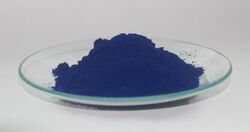Medicine:Prussian blue (medical use)
 Prussian blue | |
| Clinical data | |
|---|---|
| Trade names | Radiogardase, others |
| AHFS/Drugs.com | Monograph |
| Pregnancy category |
|
| Routes of administration | by mouth |
| ATC code | |
| Identifiers | |
| CAS Number | |
| PubChem CID | |
| ChemSpider | |
| UNII | |
| Chemical and physical data | |
| Formula | C18Fe7N18 |
| Molar mass | 859.24 |
Prussian blue, also known as potassium ferric hexacyanoferrate, is used as a medication to treat thallium poisoning or radioactive caesium poisoning.[1][2] For thallium it may be used in addition to gastric lavage, activated charcoal, forced diuresis, and hemodialysis.[3][4] It is given by mouth or nasogastric tube.[2][4] Prussian blue is also used in the urine to test for G6PD deficiency.[5]
Side effects may include constipation, low blood potassium, and stools that are dark.[1][3] With long-term use, sweat may turn blue.[3] It mainly works by trapping the toxic monovalent cations in its crystal lattice after ion-exchange with potassium or ammonium cations and thus preventing the absorption of thallium and radio-caesium from the intestines.[3]
Prussian blue was developed around 1706.[6] It is on the World Health Organization's List of Essential Medicines.[7] (As of 2016), it is only approved for medical use in Germany, the United States, and Japan.[8][9][10] Access to medical-grade Prussian blue can be difficult in many areas of the world including the developed world.[11]
Medical uses
Prussian blue is used to treat thallium poisoning or radioactive caesium poisoning.[1][2][12] It may also be used for exposure to radioactive material until the underlying type is determined.[3][clarification needed]
Often it is given with mannitol or sorbitol to increase the speed it moves through the intestines.[4]
Prussian blue is also used to detect hemosiderin in urine to confirm a diagnosis of G6PD deficiency.[5]
Thallium poisoning
For thallium it may be used in addition to gastric lavage, forced diuresis, and hemodialysis.[3]
It is given until the amount of thallium in the urine drops to below 0.5 mg per day.[4]
Caesium poisoning
It is specifically only used for radioactive caesium poisoning when the caesium has entered the body either by swallowing or breathing it in.[4]
References
- ↑ 1.0 1.1 1.2 WHO Model Formulary 2008. World Health Organization. 2009. p. 65. ISBN 9789241547659.
- ↑ 2.0 2.1 2.2 Hamilton, Richart (2015). Tarascon Pocket Pharmacopoeia 2015 Deluxe Lab-Coat Edition. Jones & Bartlett Learning. p. 472. ISBN 9781284057560.
- ↑ 3.0 3.1 3.2 3.3 3.4 3.5 "Prussian Blue". The American Society of Health-System Pharmacists. https://www.drugs.com/monograph/prussian-blue.html.
- ↑ 4.0 4.1 4.2 4.3 4.4 "Elimination Enhancement" (in en). Medical Toxicology. Lippincott Williams & Wilkins. 2004. p. 248,279. ISBN 9780781728454. https://books.google.com/books?id=BfdighlyGiwC&pg=PA270.
- ↑ 5.0 5.1 "Glucose-6-phosphate dehyrogenase deficiency". Medlibes: Online Medical Library. 28 July 2010. http://medlibes.com/entry/glucose-6-phosphate-dehyrogenase-deficiency.
- ↑ "Physicochemical Properties, synthesis, applications, and transport" (in en). Toxicology of Cyanides and Cyanogens: Experimental, Applied and Clinical Aspects. John Wiley & Sons. 2015. p. 43. ISBN 9781118628942. https://books.google.com/books?id=rF2-CgAAQBAJ&pg=PA43.
- ↑ World Health Organization model list of essential medicines: 21st list 2019. Geneva: World Health Organization. 2019. WHO/MVP/EMP/IAU/2019.06. License: CC BY-NC-SA 3.0 IGO.
- ↑ "Organ-Specific Therapeutic Intervention" (in en). Metal Toxicology: Approaches and Methods. Elsevier. 2016. p. 93. ISBN 9781483288567. https://books.google.com/books?id=DiElBQAAQBAJ&pg=PA93.
- ↑ "Thallium" (in en). Clinical Neurotoxicology: Syndromes, Substances, Environments. Elsevier Health Sciences. 2009. p. 280. ISBN 978-0323052603. https://books.google.com/books?id=Pmcy24y2HyMC&pg=PA280.
- ↑ "Radioaktivität: Berliner Blau als Arzneimittel" (in de). Deutsches Ärzteblatt. 1 July 2011. https://www.aerzteblatt.de/archiv/95515/Radioaktivitaet-Berliner-Blau-als-Arzneimittel.
- ↑ "Fukushima's Caesium Spew - Deadly Catch-22s in Japan Disaster Relief". Truthout. 27 June 2011. https://truthout.org/articles/fukushima-s-cesium-spew-deadly-catch-22s-in-japan-disaster-relief/.
- ↑ "Questions and Answers on Calcium-DTPA and Zinc-DTPA (Updated)". 3 November 2018. https://www.fda.gov/drugs/bioterrorism-and-drug-preparedness/questions-and-answers-calcium-dtpa-and-zinc-dtpa-updated.
 |

